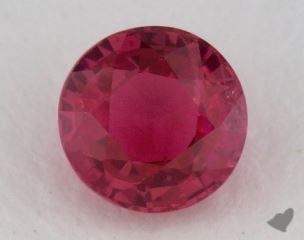Red Rubies
While rubies are universally accepted as red corundum, there are differing opinions on what constitutes a ruby versus a pink sapphire. Rubies receive their red color from high levels of the trace element chromium just as a pink sapphire has traces of chromium. It is the saturation that defines the category in which the corundum falls. In some Asian markets, rubies with traces of pink are acceptable while in the European and North American markets, red and pink corundum is often delegated into two separate color categories.
Color is by far, the most important to consider when evaluating a Ruby, with transparency being the secondary concern. Objective color determination has been difficult to achieve for rubies. Ancient trade terms such as “pigeon’s blood,” “pomegranate,” “saffron,” and “China rose” have long been used to describe the color of a ruby. However, these terms are not universally recognized and an objective system for evaluating rubies did not exist until recently.
The lines between the color boundaries of pink and red are often blurred. In the case of rubies, the ideal color is a vivid, medium-dark red to slightly purplish red with a medium to medium-dark tone and either strong or vivid saturation. Many fine rubies from Myanmar have a slight purple secondary color while Thai rubies have been said to exhibit a “garnet red” color due to their dark tone. If the ruby can fluoresce, that attribute can intensify the gemstone’s color while rutile needles have the ability to reflect light and also heighten the color.
A ruby’s unique ability to fluoresce is sometimes used in determining its origin as well as proving that a ruby is indeed a ruby. Burmese rubies, which are often formed in marble, tend to have fluorescence while Thai and Cambodian rubies, which form within basaltic, (iron-rich rocks) do not fluoresce.
Like sapphires, rubies are not subject to the same clarity expectations as diamonds. Natural rubies and sapphires are far rarer and are not graded at 10x magnification. Rather, they are graded and viewed on eye level; a high clarity ruby would be considered "eye clean."
The most famous ruby sources are Myanmar (Burma) and Sri Lanka (Ceylon). However, Vietnam and Thailand, in Afghanistan, Africa, Cambodia, India, Kashmir, Laos, Nepal, Pakistan, Tajikistan and the United States (North Carolina) are also notable resources
Myanmar, formerly known as Burma, has been a key source of the highest quality rubies for centuries. The illustrious Burmese ruby will have the perfect combination of intense color, silk, and strong fluorescence.
Rubies from Myanmar are mainly found in two locations: the famous Mogôk Valley, and Möng Hsu. While exact dates are hard to come by, it is believed that the Mogôk Valley has been a source of rubies for almost a thousand years. The Möng Hsu area was only recently developed in the 1990s. In 2008 Congress passed an act that banned the importation of Burmese jade and ruby into the United States. Prices for Burmese rubies are at a premium as the number of gemstone for sale is limited to items imported before the act.
Sri Lanka has a long history with gemstone formations and throughout history has been dubbed “Island of Gems.” Sri Lankan rubies tend to be more brilliant, lighter in color tones that contain pink or purple secondary colors, as well as higher clarity than rubies from other locations. Other characteristics include a strong fluorescence, color zoning, and the presence of silk.





